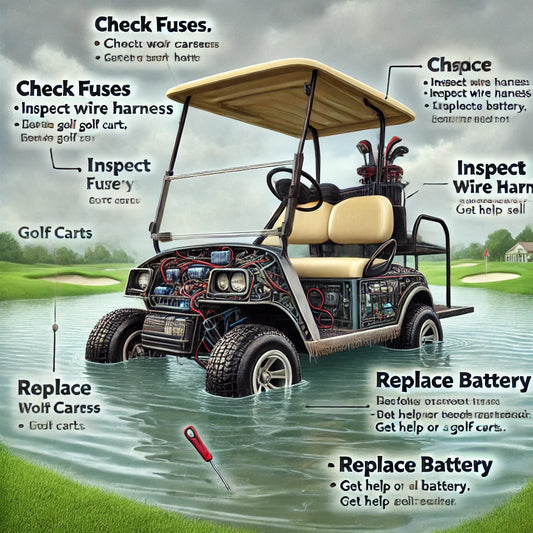Hey y'all, Mechanic Mike here! Let's talk about a crucial aspect of golf cart maintenance that often gets overlooked: tire pressure. Keeping your golf cart tires properly inflated is essential for safety, performance, and extending the life of your tires. Today, I'll walk you through everything you need to know about maintaining the right tire pressure for your golf cart.
Why Proper Tire Pressure Matters
1. Safety
Properly inflated tires ensure better handling and stability, reducing the risk of accidents. Underinflated tires can cause poor traction and increase the likelihood of a blowout, while overinflated tires can lead to a rough ride and less grip on the ground.
2. Performance
Maintaining the correct tire pressure optimizes your golf cart's performance. It ensures smooth and efficient movement, improves battery life for electric carts, and reduces fuel consumption for gas-powered carts.
3. Tire Longevity
Correct tire pressure helps prevent premature wear and tear. Underinflated tires can wear out on the edges, while overinflated tires tend to wear out in the center. Keeping your tires at the proper pressure distributes wear evenly, extending their lifespan.
Recommended Tire Pressure
Standard Golf Cart Tires
Most standard golf cart tires require a pressure range of 15 to 25 PSI (pounds per square inch). Always refer to the manufacturer's specifications for the exact pressure recommendation.
- Low-Pressure Range: 15-18 PSI (for a softer ride and better traction on rough terrain)
- High-Pressure Range: 20-25 PSI (for a firmer ride and better performance on smooth surfaces)
Specialty Tires
For specialty tires, such as off-road or turf tires, the recommended pressure may differ. Check the sidewall of the tire or the manufacturer's guidelines for the correct PSI.
How to Check and Adjust Tire Pressure
Tools You'll Need
- Tire Pressure Gauge: A reliable gauge to measure the current tire pressure.
- Air Compressor or Pump: To inflate the tires to the proper pressure.
- Valve Stem Caps: To protect the valve stems and prevent air leaks.
Step-by-Step Guide
- Check Tire Pressure: Use the tire pressure gauge to check the pressure of each tire when they are cold (before you've driven the cart).
- Compare to Recommended PSI: Compare the measured pressure to the manufacturer's recommended PSI.
-
Adjust Pressure:
- To Inflate: Attach the air compressor or pump to the valve stem and add air in short bursts, checking the pressure frequently.
- To Deflate: Press the small pin inside the valve stem to release air until the correct pressure is reached.
- Recheck Pressure: After adjusting, recheck the pressure to ensure it is at the recommended level.
- Replace Valve Stem Caps: Secure the valve stem caps to protect against leaks.
Tips for Maintaining Proper Tire Pressure
Regular Checks
Check your tire pressure at least once a month and before any long rides. Temperature changes can affect tire pressure, so check more frequently during extreme weather conditions.
Visual Inspections
Regularly inspect your tires for signs of damage, such as cracks, bulges, or embedded objects. Address any issues immediately to avoid more significant problems.
Keep a Log
Maintain a log of your tire pressure checks and adjustments. This practice helps you track any patterns or recurring issues with your tires.
Conclusion
Maintaining the proper tire pressure for your golf cart is a simple but essential task that ensures safety, performance, and longevity of your tires. Remember to check your tire pressure regularly and adjust as needed according to the manufacturer's recommendations. If you have any questions or need further assistance, feel free to reach out to Mechanic Mike. Happy driving, y'all!




